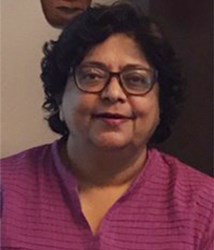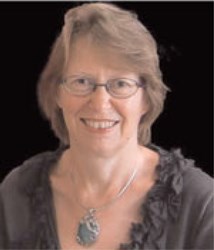 Professor Jyothi Gupta
Professor Jyothi Gupta
 Professor Clare Hocking
Professor Clare Hocking
Globalization of national economies and international trade agreements have opened up borders for movement of goods, services, and people. The movement of people has not been without controversy and, more than ever, immigration is attracting headlines the world over. It remains the case that the majority of migrants move from less-developed to more affluent countries. While reasons for immigration are complex, with some people choosing to immigrate for better work opportunities, many others are fleeing persecution and conflict, seeking refuge and asylum in order to survive.
Regardless of the reasons for immigration, moving to a country with unfamiliar cultural norms, behaviours, and expectations poses a number of threats to well-being. Previous occupational science research has revealed that the transition from a familiar to an unfamiliar environment may profoundly impact people’s opportunities, means and ability to engage in meaningful occupations. There are environmental influences on what they chose to do, and how and where they do it and, as a consequence, alteration to their pattern of occupation and health status. Viewed from a transactional perspective, occupation may be a vehicle to create a sense of being and belonging, and a means of creating cross-cultural understanding amongst both immigrants and established residents.
This issue of the Journal of Occupational Science features seven papers addressing the occupations and well-being of immigrants: five focus on the experiences of voluntary immigrants and two are concerned with the restricted occupations of asylum seekers. The papers build on the 2012 special issues of JOS that also presented an occupational perspective of the well-being of immigrants, refugees and asylum seekers. Setting the scene, Rivas-Quarneti, Movilla-Fernández, and Magalhães (Citation2018) report the daily occupational struggles of six women from Latin America who have immigrated to Spain. Enacting occupational scientists’ commitment to social transformation, these authors take an occupational justice perspective and reveal how ethnicity, class, gender and socio-economic realities interact to shape the occupational opportunities open to the women. Primary amongst these are the reduced employment opportunities after the global financial crisis, deep-seated sexualised stereotypes of Latin-American women, and lack of legal and social protections. The paper is important in adopting a critical stance towards issues of health and occupation, and its use of critical narrative analysis.
Kielsgaard, Kristensen and Nielsen (Citation2018) follow with their exploration of the occupational lives of migrant mothers in Denmark who have separated from their husbands. Again, financial constraints and separation from extended family loom large in shaping the women’s occupation. Their realities, however, are also coloured by stress disorders brought on by historic trauma, the difficult position of Arabic women choosing to live apart from their husbands, and fragile social connections. Creating a stable family life for their children and managing stress become drivers of everyday occupations, but also result in boredom and lack of progress towards previously held occupational goals.
The environmental perspectives introduced by Rivas-Quarneti and colleagues (Citation2018) and Kielsgaard and colleagues (Citation2018) carry through to Huot and Veronis’ (Citation2018) examination of the role community spaces such as schools, places of worship, and community centres have in enabling migrants’ performance of intersectional identities. Drawing insights from 56 French-speaking immigrants and refugees who settled in Anglophone dominant cities in Canada, the authors conclude that community spaces provide important opportunities for linguistic minority community members to engage in meaningful occupations. These findings are tempered, however, by the observation that the heterogeneity of the populations must be taken into account in efforts to enable integration. Of particular importance is the relationship of newly arrived minority group members with those who are already established in that locality.
Shifting the focus to older immigrants, Wright-St Clair, Nayar, Kim, Wang, Sodhi, Chung, Suchdev, and Hu (Citation2018) engaged with late-life Chinese, Indian, and Korea immigrants to New Zealand to explore how they use participation in their local communities to influence their subjective health. A core social process of strengthening community was identified. Participants strove to stay healthy by being culturally connected, and giving service with and for each other. Over time, the focus of their actions tended to extend to the wider community, as they used long-standing skills for making and doing things to contribute to community health. A key impetus to their actions was to minimise potential burden on the national health system. Complimenting those findings, Arola, Dellenborg, and Häggblom-Kronlöf (Citation2018) interviewed older Finnish people who, several decades ago, had moved to Sweden to work. While the cultural differences they encountered were not so marked, participants similarly reported maintaining a subjective feeling of health by staying in contact with other immigrants from Finland, while at the same time doing things with people in their host country to develop a sense of belonging.
In contrast to the experiences of those older immigrants, asylum seekers in South Tyrol in Italy were most concerned about work opportunities, which they perceived to be the pathway to improved subjective well-being. They described work as overcoming their social and spatial isolation in society, and as bringing peace of mind, identity and a broader sphere of action (Lintner & Elsen, Citation2018). Similar to previous accounts of refugees and asylum seekers deprived of productive occupation, not having opportunities to occupy themselves resulted in excessive rumination about their past and future, feelings of uselessness and diminished psychological well-being (See for example Burchett & Matheson, Citation2010; Crawford, Turpin, Nayar, Steel, & Durand, Citation2016). Harking back to Wright St. Clair et al. (Citation2018), however, Smith (Citation2018) reports that asylum seekers in the United Kingdom who found meaningful things to do for others were better able to meet their personal and cultural needs. Motivated by learned behaviours and moral principles, kinship ties and empathy, their altruistic occupations appeared to promote a sense of connection with others and a positive sense of self. Perhaps most important, altruistic acts created connection between past and present occupations, which Smith termed ‘occupational constancy’.
Two further articles and a contribution to Teaching Occupation round out this issue of JOS. The themes of connection to family, community, and culture continue through to Beagan, Chapman, and Power’s (Citation2018) study of the food provisioning occupations of 31 low-income families in Canada. Circumventing barriers imposed by their financial circumstances, limited access to transportation, and competing priorities, low-income shoppers displayed an array of strategies and skills, as well as their capacity for planning. Resisting dominant discourses that position them as lazy, uneducated and irresponsible, these shoppers perceive themselves to be frugal, knowledgeable, skilled consumers and, by enacting those skills, to demonstrate their aspirations to be good parents.
Horghagen, Magnus, Anthun, Knudtsen, Wist, and Lillefjell (Citation2018) introduce a new theme to this collection of papers; involving citizens in planning and implementing public health initiatives for a community. One of the primary challenges, how to get people involved, was the topic of this study. The authors identify the issues as addressing justice for all sectors of the community, generating a sense of ownership of the process and outcomes, creating a sense of togetherness, and the challenge of translating the values and identity of the city into concrete structures. Doing so requires trust, consideration of different needs and priorities, and harnessing people’s creativity while building their confidence. Getting the process right is indeed a challenge, but the rewards are reflected in the successful implementation of public health policy.
The complexity of occupation evident through the feature articles in this issue of JOS point to what makes it a challenging concept to teach. Compounding the problem, the terms activity, purposeful activity and occupation are used interchangeably across the literature. Definitions of occupation are also evolving over time, creating further challenges for educators who have responded by employing varying pedagogic methods, which the authors outline. In response, Howarth, Morris, and Cox (Citation2018) propose that occupation is a threshold concept and report on a teaching tool being developed to teach occupation as a discrete concept.
We look forward to continuing the conversation of what occupation means in different contexts, and revealing even more of its complexities in the future. See the call for papers from the World Federation of Occupational Therapy’s 2018 Congress, which promises new discussions informed by its location in Africa.
ORCID
Clare Hocking http://orcid.org/0000-0003-0364-5157
References
- Arola, L. A., Dellenborg, L., & Häggblom-Kronlöf, G. (2018). Occupational perspective of health among persons ageing in the context of migration. Journal of Occupational Science, 25(1), 65–75. doi: 10.1080/14427591.2017.1368411
- Beagan, B. L., Chapman, G. E., & Power, E. (2018). The visible and invisible occupations of food provisioning in low income families. Journal of Occupational Science, 25(1), 100–111. doi: 10.1080/14427591.2017.1338192
- Burchett, N., & Matheson, R. (2010). The need for belonging: The impact of restrictions on working on the well-being of an asylum seeker. Journal of Occupational Science, 17(2), 85-91. doi:10.1080/14427591.2010.14427591 doi: 10.1080/14427591.2010.9686679
- Crawford, E., Turpin, M., Nayar, S., Steel, E., & Durand, J.-L. (2016). The structural-personal interaction: Occupational deprivation and asylum seekers in Australia. Journal of Occupational Science, 23(3), 321–338. doi: 10.1080/14427591.2016.1153510
- Horghagen, S., Magnus, E., Anthun, K. S., Knudtsen, M. S., Wist, G., & Lillefjell, M. (2018). Involving citizens’ occupation-based knowledge in public health planning: Why and how. Journal of Occupational Science, 25(1), 112–123. doi: 10.1080/14427591.2017.1391113
- Howarth, J. T., Morris, K., & Cox, D. L. (2018). Challenges of teaching occupation: Introduction to an occupation focused teaching tool. Journal of Occupational Science, 25(1), 142–148. doi: 10.1080/14427591.2017.1397535
- Huot, S., & Veronis, L. (2018). Examining the role of minority community spaces for enabling migrants’ performance of intersectional identities through occupation. Journal of Occupational Science, 25(1), 37–50. doi: 10.1080/14427591.2017.1379427
- Kielsgaard, K., Kristensen, H. K., & Nielsen, D. S. (2018). Everyday life and occupational deprivation in single migrant mothers living in Denmark. Journal of Occupational Science, 25(1), 19–36. doi: 10.1080/14427591.2018.1445659
- Lintner, C., & Elsen, S. (2018). Getting out of the seclusion trap? Work as meaningful occupation for the subjective well-being of asylum seekers in South Tyrol, Italy. Journal of Occupational Science, 25(1), 76–86. doi: 10.1080/14427591.2017.1373256
- Rivas-Quarneti, N., Movilla-Fernández, M-J., & Magalhães, L. (2018). Immigrant women’s occupational struggles during the socioeconomic crisis in Spain: Broadening occupational justice conceptualization. Journal of Occupational Science, 25(1), 6–18. doi: 10.1080/14427591.2017.1366355
- Smith, H. C. (2018). Finding purpose through altruism: The potential of ‘doing for others’ during asylum. Journal of Occupational Science, 25(1), 87–99. doi: 10.1080/14427591.2017.1371633
- Wright-St Clair, V. A., Nayar, S., Kim, H., Wang, S. M., Sodhi, S. K., Chung, A., Suchdey, J., & Hu, C. (2018). Late-life Asian immigrants managing wellness through contributing to socially embedded networks. Journal of Occupational Science, 25(1), 51–64. doi: 10.1080/14427591.2017.1370607
